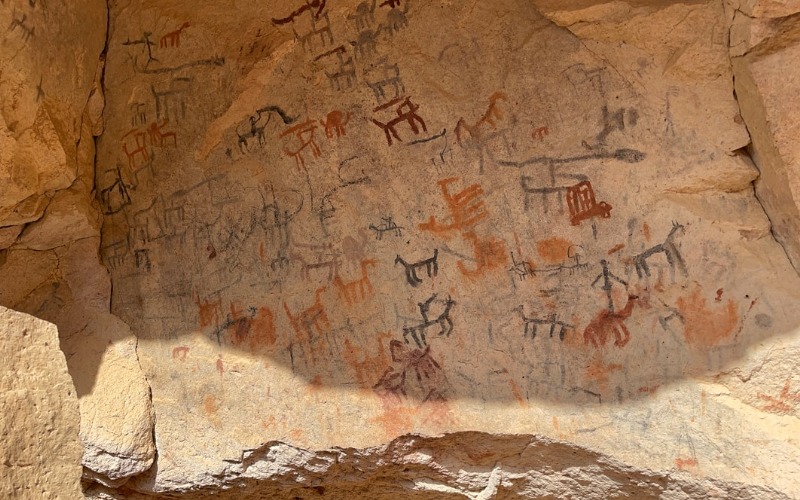Things To Do In New Mexico
Contents
Since my family decided to take a trip to the New Mexico in the winter, we weren’t looking for sunshine, warmth, or desert resorts but for a different kind of adventure.
We wanted to tour the “Land of Enchantment” off-season, with fewer tourists about and more uncrowded opportunities to visit a region that has been occupied by humans for millennia, in which native peoples had established their cultures long before Europeans came to North America.

Flying into Albuquerque, New Mexico’s largest city, we found its airport much easier to navigate than crowded, confusing SeaTac. After staying in town a few days to orient ourselves, visiting its excellent zoo and several museums, we headed north via the Rail Runner Express. This commuter train runs 60 miles between Albuquerque and Santa Fe.
Santa Fe and the Pueblos
It’s easy to see why Santa Fe is such a tourist mecca. The city is chock full of great museums, art galleries, shops, and restaurants, all easily accessible downtown by a free public transit system called the Santa Fe Pickup.
At the central Santa Fe Plaza, created by the Spanish King Felipe II in 1660, dozens of Native American artisans spread out their wares for sale in front of the Palace of Governors — jewelry, pottery, and other crafts. While some of these items are just tourist kitsch, most are of exceptional quality (and exceptional prices) — silver bracelets, inlaid stone ornaments, pottery with intricate designs, and of course, a lot of turquoise jewelry.

Artisan craftspeople are primarily residents of the 19 surrounding pueblos in the area.
And while many of these pueblos are easily accessible by car, they are not tourist traps. These are self-governing, independent towns that have been part of the New Mexican landscape for hundreds of years.
After the Spanish subjugated them in the 17th Century, the pueblo people staged a successful revolt in 1680 to regain independence. After Spain finally defeated them in 1696, they eventually allowed them the right of self-government.
The people who live in the pueblos now value their privacy and independence. They usually forbid photographs to be taken of them or their adobe-style homes, even on special days when they hold dances or other events open to the general public. A few casinos and visitor centers are more welcoming to strangers outside the town limits, but except for a few shops, pueblos are closed to visitors.
In Isleta Pueblo, 25 miles south of Albuquerque, we saw the massive St. Augustine mission church, first built in 1613 in the adobe style and one of the oldest mission churches still standing in the U.S. It was destroyed during the Pueblo Revolt and rebuilt on its original foundation in 1716.
We were unable to go inside, as we were able in most Catholic churches. However, another sign of the privacy the pueblo intends to protect. We also visited other pueblos, including Cochiti and Sandia.
Cliff Dwellings at Bandelier
Just 46 miles west of Santa Fe, the Bandelier National Monument in Frijoles Canyon contains the most accessible cliff dwellings in the state — accessible, that is, if you are willing to climb steep stone steps and wooden ladders to reach them.
One large cave called the Alcove requires climbing 140 feet up a cliff in order to get there on four very tall wooden ladders bolted to the rock. On top, a kiva, or sacred stone structure, is entered by a hole on its roof (as were most of the cliff dwellings). Unfortunately, it was closed when we were there.

Many other shallow caves pockmark the cliffs. They were not lived in but used instead for storage and making crafts with stone dwellings built against them that are now long gone.
It’s not known when or why the native peoples abandoned these cliffside homes in about 1550 BCE. Drought, warfare, or even disease have been factors.
But some low stone walls that once encircled gardens below the cliffs, where corn and other crops were once grown, remain. There’s an eerie atmosphere about the place as if the ghosts of ancient people still inhabit it.
Petroglyphs near Albuquerque
I’ve always been fascinated by petroglyphs — images made by native peoples on rocks for art, religious purposes, or some other unknown reason.
West of Albuquerque, we visited Petroglyph National Monument, where over 20,000 petroglyphs have been found on basalt clumps scattered over 7,000 acres.

Pictures of sheep, goats and other animals, people, and tribal symbols are everywhere, most of them between 400 and 700 years old. The site is currently under threat of development by Albuquerque, which owns some of the surrounding lands.
Carlsbad Caverns and White Sands
Driving south on highway 285 through many miles of uninhabited high desert (Albuquerque itself is over 5,200 feet in elevation, Santa Fe over 6,600 feet), the vast scale of New Mexico is immediately apparent.
A few cattle and some oil rigs were all to be seen. With snow-capped mountains far in the distance, after some 220 miles, passing Roswell (with no UFOs in sight), we eventually reached the town of Carlsbad, a long strip of motels, gas stations, restaurants, and shopping malls that seemed entirely out of place on the barren landscape.
Just 18 miles farther down the road is White’s City, not a bastion of Caucasian supremacy as its title might suggest, but named instead for Jim White, a cowboy, and rancher who discovered the nearby Carlsbad Caverns as a teenager in 1898. Its entrance lies just outside town.
I’ve been to many impressive caves in North America, Spain, and France, but nothing as vast and magical as Carlsbad.
Once inside Carlsbad Caverns National Park, a world UNESCO site, visitors must descend 750 feet on a steep, 1.2-mile paved trail with innumerable switchbacks to reach the bottom of the cave. This experience felt like walking down into the very bowels of the earth through multiple layers of time.

Once at the bottom, a 1.7-mile trail loops around the Big Room, the size of 14 football fields — the most extensive cave chamber yet discovered in North America.
I had envisioned a giant, cathedral-like chamber with a soaring high ceiling. While the visible roof of the cave is high enough, the space of this room is more like the long, segmented nave of a Gothic church, with substantial crystalline limestone stalactites hanging down like chandeliers above a floor packed with a congregation of silent worshipper stalagmites, some quite small, others as much as 60 feet tall.
The fantastic shapes of these limestone forms bear more resemblance to the fantastic work of the Spanish architect Gaudí than the classical Renaissance creations of Michelangelo.
Park officials have taken great care to light them so as not to change their natural color, which was far more monochromatic than we expected. After hiking through a generous sampling of these natural wonders, we were relieved to find elevators to take us back to the surface. Hiking back up would not have been a pleasant experience.

Not far from the caverns is White Sands National Monument. Many miles of sparkling white dunes composed of tiny gypsum crystals (not sand) stretch to the horizon — a moonscape that exists nowhere else on the planet.
We drove a loop road plowed through part of the dunes, then climbed up on them in bright sunshine and a fierce cold wind. We watched children and adults slide down the dunes on plastic sleds like kids enjoying a snow day from school.
Unique and beautiful as the White Sands area, the grim reality of the region lies close by — a government missile testing range and the infamous Trinity Site, where the first atomic bomb, the most dangerous weapon ever created — and used— by humanity, was set off in 1945.
And so New Mexico’s historical past, still visible, still accessible, remains for me a monument to the light and dark of human achievement — and a reminder that our future depends on how we must continue to respect and preserve the earth and the people who live on it.



